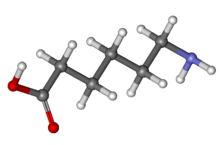Aminocaproic acid
 | |
 | |
| Clinical data | |
|---|---|
| Trade names | Amicar |
| AHFS/Drugs.com | Monograph |
| MedlinePlus | a608023 |
| ATC code | B02AA01 (WHO) |
| Legal status | |
| Legal status |
|
| Pharmacokinetic data | |
| Metabolism | Renal |
| Biological half-life | 2 hours |
| Identifiers | |
| |
| CAS Number |
60-32-2 |
| PubChem (CID) | 564 |
| IUPHAR/BPS | 6574 |
| DrugBank |
DB00513 |
| ChemSpider |
548 |
| UNII |
U6F3787206 |
| KEGG |
D00160 |
| ChEBI |
CHEBI:16586 |
| ChEMBL |
CHEMBL1046 |
| NIAID ChemDB | 018631 |
| Chemical and physical data | |
| Formula | C6H13NO2 |
| Molar mass | 131.173 g/mol |
| 3D model (Jmol) | Interactive image |
| Melting point | 205 °C (401 °F) |
| |
| |
| (verify) | |
Aminocaproic acid (also known as ε-aminocaproic acid, ε-Ahx, or 6-aminohexanoic acid) is a derivative and analogue of the amino acid lysine, which makes it an effective inhibitor for enzymes that bind that particular residue. Such enzymes include proteolytic enzymes like plasmin, the enzyme responsible for fibrinolysis. For this reason it is effective in treatment of certain bleeding disorders, and it is marketed as Amicar. Aminocaproic acid is also an intermediate in the polymerization of Nylon-6, where it is formed by ring-opening hydrolysis of caprolactam.
Medical use
Aminocaproic acid (Amicar) is FDA-approved for use in the treatment of acute bleeding due to elevated fibrinolytic activity.[1] It also carries an Orphan Drug designation from the FDA for the prevention of recurrent hemorrhage in patients with traumatic hyphema.[2] In clinical practice, aminocaproic acid is frequently used off-label for control of bleeding in patients with severe thrombocytopenia,[3] control of oral bleeding in patients with congenital and acquired coagulation disorders,[4] control of perioperative bleeding associated with cardiac surgery,[5][6] prevention of excessive bleeding in patients on anticoagulation therapy undergoing invasive dental procedures,[7] and reduction of the risk of catastrophic hemorrhage in patients with acute promyelocytic leukemia.[8]
References
- ↑ Amicar[R] [FDA label]. http://www.accessdata.fda.gov/drugsatfda_docs/label/2004/15197scm036,scf037,scp038,scm039_amicar_lbl.pdf. Accessed August 20, 2016
- ↑ Food and Drug Administration. Orphan designations pursuant to section 526 of the Federal Food and Cosmetic Act as amended by the Orphan Drug Act (P.L. 97-414) to June 28, 1996. Rockville, MD; 1996 Jul.
- ↑ Bartholomew JR; Salgia R; Bell WR (1989-09-01). "Control of bleeding in patients with immune and nonimmune thrombocytopenia with aminocaproic acid". Archives of Internal Medicine. 149 (9): 1959–1961. doi:10.1001/archinte.1989.00390090039008. ISSN 0003-9926.
- ↑ Lucas, O. N.; Albert, T. W. (1981-02-01). "Epsilon aminocaproic acid in hemophiliacs undergoing dental extractions: a concise review". Oral Surgery, Oral Medicine, and Oral Pathology. 51 (2): 115–120. ISSN 0030-4220. PMID 6782532.
- ↑ Lu, Jun; Meng, Haoyu; Meng, Zhaoyi; Sun, Ying; Pribis, John P.; Zhu, Chunyan; Li, Quan (2015-01-01). "Epsilon aminocaproic acid reduces blood transfusion and improves the coagulation test after pediatric open-heart surgery: a meta-analysis of 5 clinical trials". International Journal of Clinical and Experimental Pathology. 8 (7): 7978–7987. ISSN 1936-2625. PMC 4555692
 . PMID 26339364.
. PMID 26339364. - ↑ Chen, R. H.; Frazier, O. H.; Cooley, D. A. (1995-01-01). "Antifibrinolytic therapy in cardiac surgery". Texas Heart Institute Journal. 22 (3): 211–215. ISSN 0730-2347. PMC 325256
 . PMID 7580358.
. PMID 7580358. - ↑ Patatanian, Edna; Fugate, Susan E. (2006-12-01). "Hemostatic mouthwashes in anticoagulated patients undergoing dental extraction.". The Annals of Pharmacotherapy. 40 (12): 2205–2210. doi:10.1345/aph.1H295. ISSN 1542-6270. PMID 17090725.
- ↑ Wassenaar, T.; Black, J.; Kahl, B.; Schwartz, B.; Longo, W.; Mosher, D.; Williams, E. (2008-12-01). "Acute promyelocytic leukaemia and acquired α-2-plasmin inhibitor deficiency: a retrospective look at the use of epsilon-aminocaproic acid (Amicar) in 30 patients". Hematological Oncology. 26 (4): 241–246. doi:10.1002/hon.867. ISSN 1099-1069. PMC 3496178
 . PMID 18613223.
. PMID 18613223.
Further reading
- Alkjaersig N, Fletcher AP, Sherry S (April 1959). "xi-Aminocaproic acid: an inhibitor of plasminogen activation". The Journal of Biological Chemistry. 234 (4): 832–7. PMID 13654273.
- Kang Y, Lewis JH, Navalgund A, Russell MW, Bontempo FA, Niren LS, Starzl TE (June 1987). "Epsilon-aminocaproic acid for treatment of fibrinolysis during liver transplantation". Anesthesiology. 66 (6): 766–73. doi:10.1097/00000542-198706000-00010. PMC 2965586
 . PMID 3296855.
. PMID 3296855.